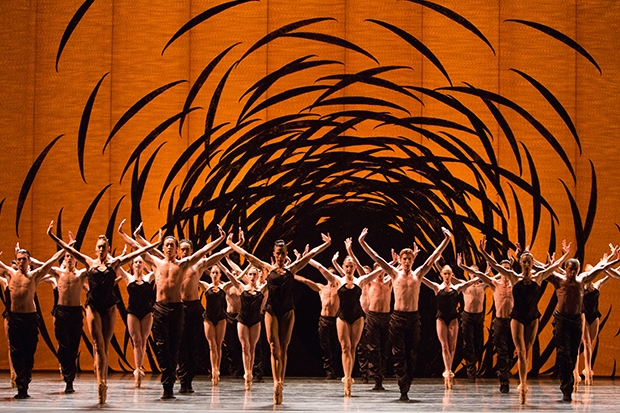Crystal Pite, the Canadian dancemaker who combines intellectual, emotional and physical intelligence in rare degree, is classically trained, but her work is most often made for and performed by contemporary companies. Hence the attraction of this Edinburgh International Festival programme. Scottish Ballet, in the European premiere of a piece Pite made for the National Ballet of Canada in 2009, offered a rare chance to see how her distinctive sensibility plays on the refined bodies of a classical company, and promised to whet the appetite for her upcoming creation for the Royal Ballet in March next year.
Emergence confronts explicitly the tension between Pite’s experiences of working with contemporary dancers in egalitarian companies and the strict hierarchy of classical ballet. Taking the social life of bees as an inspiration, it plays with the fine lines between cooperation and coercion, discipline and dictatorship. In oscillating formations that constantly hint at iconic corps de ballet groupings (straight lines like the swans in Swan Lake, a one-by-one entry like the Shades in La Bayadère), the women and men of the company flow back and forth across the stage in waves that might or might not be antagonistic: there is no violence, but there is an air of menace as the women, with their spiky elbows held stiffly behind them like wings, begin to make a rustling sound. They are counting out loud, whispering the beats — like soldiers marching, yes, but also making audible their own usually-silent monologue. It’s simple, and utterly gripping: reminiscent of William Forsythe’s silent clock-like Duo. Pite, who danced with Ballett Frankfurt under Forsythe, shares his way with rhythm and the deconstruction of ballet vocabulary (a flat-footed rond de jambe sequence is one of Emergence’s most memorable visuals), but combines it with her own talent for making large groups move in fascinating organic shapes. Emergence starts slowly, but it builds to a throat-tightening climax that is pure Pite, with the massed dancers moving in crisp, fugal sequences, polyphony for the eyes, against the burning light of the ‘hive’ tunnel at the centre of Jay Gower Taylor’s rust-bright backcloth.
Emergence was Pite’s first piece for a large classical company, and to my mind is not as exciting as her recent contemporary work: as a dancemaker of unusual skill and substance, she is by no means automatically improved by working with elite bodies. Angelin Preljocaj, on the other hand, looks very much better on a classical company. At 50 minutes long, his MC 14/22 (Ceci est mon corps) was a marathon opener, and most of its best bits came courtesy of the Scottish Ballet dancers, 12 men who slide through the choreography like so many high-performance racing cars. Sinuous spines, wide-flung arms, sleekness and precision in an intricate quartet, all show off the dancers as aristocrats of their art.
But fine dancers, no matter how beautiful (and with their bare chests and little white pants, they are very beautiful), cannot rescue nearly an hour of laboured religious allegory. The Last Supper allusion of the title is picked up at multiple points in a piece where an apostolic number of dancers share the stage with several tables: the dancers thump their chests with one fist as at the non sum dignus, they mime feeding themselves and each other as if distributing Hosts, they circle arms and hands over the table tops in caressing gestures reminiscent of ritual, garbling the actions of consecration in dance the way ‘hocus pocus’ garbles the words ‘hoc est corpus meum’. One dancer sings, persistently (and for a dancer, impressively) in falsetto as two others prod and hit him; their blows punctuate the song with choking air but can’t stop it. Another is hobbled in parcel tape but continues to perform the same dance. It may suggest Christ-like giving, but it also feels like sub-Pina Bausch Tanztheater. At the piece’s nadir, one lot of men thumped and heaved the other lot on tables like butchers tenderising meat (Catholic Mass is torturous, dehumanising, degrading — geddit?), and the soundtrack’s blend of water drops and static was regularly punctuated by the clatter of a seat springing back with alacrity under the departing bottom of an audience member tried beyond the limits of patience. The final tableau, of dancers diving off a three-story tower of tables, was an arresting sight, but not enough to warm my heart towards this tedious, overlong exercise.






Comments